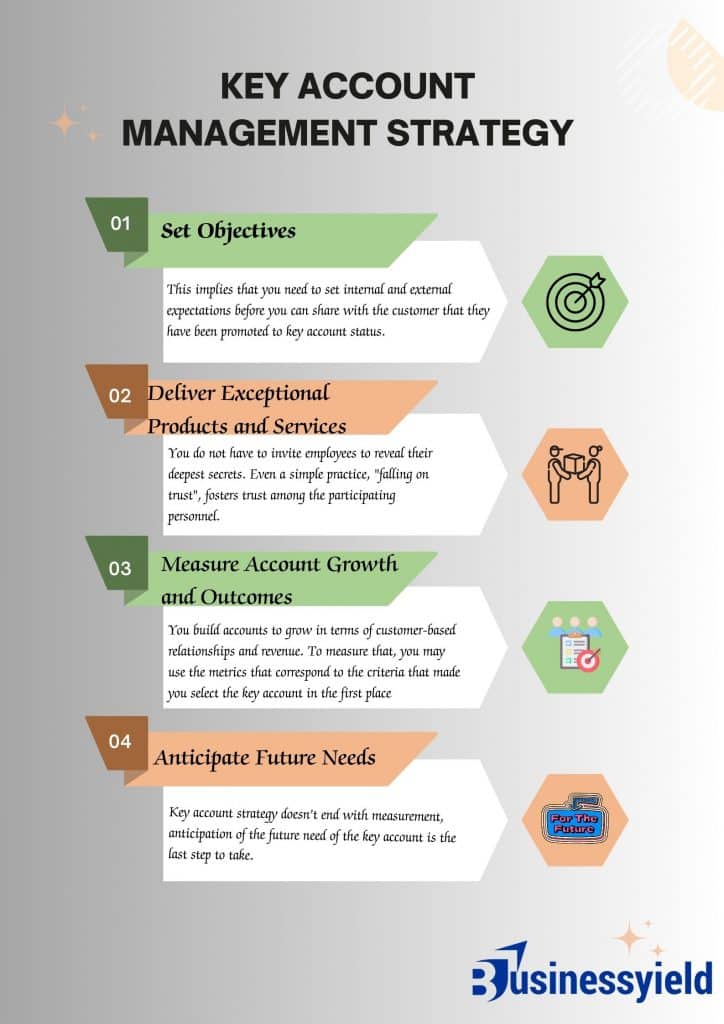Your key client requires expert suppliers to help solve their multiple problems and assist them in developing opportunities and support that will provide high value that is worth their investment. Key account management (KAM) is the perfect approach that helps companies ascertain and prioritize key clients and important customers. These accounts play a vital role in generating revenue for valuable customers, which has a big impact on your business’s success. Furthermore, I will walk you through the meaning and strategy of key account management (KAM).
Key Points
- Key account management (KAM) is the approach that helps companies ascertain and prioritize key clients and important customers.
- The goal of key account management (KAM) is to create opportunities to build partnerships with unique customers that are growing both of your companies.
- You can identify strategic accounts that are valuable through revenue volume, revenue potential, lifetime value, product fit, and overall strategic value.
- Key account management strategies include setting objectives, delivering exceptional products and services, measuring account growth and outcomes, and anticipating future needs.
What is KAM?
Key account management means identifying and taking care of valuable, large, and vital accounts of your company. Also, this account needs special attention and resources to maintain beneficial relationships. Additionally, the goal of Kam is to create opportunities to build partnerships with unique customers that are growing both of your companies. They also achieve their aim by having a deep understanding of the key accounts, goals, company needs, and challenges of tailoring company services to meet those needs. Besides, it increases the long-term benefits of strategic partnerships.
Some years ago, I worked as a sales director for a successful electronics company, Pathronics. I was assigned to oversee the key account management (KAM) strategy for our most valuable clients. I recall one account that stood out as important to our success. Afterward, the client became not just a source of revenue but also a strategic partner, strengthening and improving the company and nurturing the relationship with the client. My team and I sometimes held meetings with this key account client; in those meetings, we sought solutions that aligned with their evolving needs and shared objectives, which allowed both parties to grow successfully.
Read Also: Accounting Insights: Is Prepaid Rent an Asset or Liability on the Balance Sheet?
How to Identify Key Accounts
The process of KAM starts with recognizing and prioritizing key accounts. To achieve that, I will discuss the following points that will help you identify strategic accounts that are valuable:
#1. Revenue Volume
The standard measurement sales directors employ to find out the key accounts is the level of revenue they generate for the business. It is easy to shortlist and identify the accounts that have the greatest return. Nevertheless, I advise that you are not quick to assign recognition to accounts based on the volume of revenue alone.
I recall some time ago, I was working as a sales director in an electronics company, and a client with the highest revenue, Vicom, seemed like a good choice for a key account. Although he had significant financial contributions and transactional relationships, Cartech, a smaller company that had genuine collaboration interest and valuable feedback, became the key account. So, when Vicom terminated its contract with our company, we gained a deeper relationship with Cartech, which helped to improve our business. This experience emphasizes the importance of not relying on revenue volume when identifying key accounts.
#2. Revenue Potential
When you are done checking the account revenue volume, also check out the account revenue potential. Companies with high financial worth shouldn’t be considered alone. Truly, prioritizing accounts with the potential to bring higher revenue is a great way to secure business growth prospects. I saw the importance of considering revenue potential when I worked for a tech firm, which is one of our average-sized manufacturing customers. Even though they are not the largest contributors to revenue potential, they have a plan to expand in the future. In addition, I seized this opportunity by engaging with their team to secure their loyalty, which presented us as strategic partners. After this experience, I learned that identifying accounts that can have potential growth in the future is a vital key to long-term success in KAM.
#3. Lifetime Value
When you are through with your revenue potential, dig a little deeper and search for margins for expansion. Although a business may have large revenue potential, it might not have the structure to sustain it. Therefore, a company’s sustainability is more important than growth. I understood the importance of lifetime value after encountering a client in my previous workplace.
I worked as an account manager in the past for Snow Industries, where I encountered a client who normally places large orders. It seemed good for the key account because of the number of orders they make. Surprisingly, I found out that they were struggling to stay in business because of the competition and change in the market. So they don’t make much profit from what they buy. This experience helped me realize that making a lot of money does not qualify someone for a key account, but having clients who can grow and make money over time is more important.
#4. Product Fit
Next, it is crucial to consider accounts that meet the ideal customer profile. Always consider the accounts that match your products and services. This means that you shouldn’t only focus on clients who need your product and service but also on clients who benefit most from what you offer. Moreover, I suggest that you know and understand the needs and challenges of each key account; this will help you know how important your product and service are to your clients
#5. Overall Strategic Value
In identifying key accounts, you also need to consider the account’s overall strategic value to your business. What this means is that you need to look beyond the present or future financial value of your client and look for possible ways your business can gain from having a good relationship with them. Moreover, check whether the account’s corporate reputation is suitable for you. Also, explore their long-term vision and ascertain whether it aligns with or conflicts with yours. Finally, I suggest that you ensure you see the benefits of the long-term relationship with the account.
Checklist on How to Identify Key Account
Key Account Management Strategy
After identifying your key accounts, the next step is to apply your strategy. Learn how to do so by studying the four-step process I stated below, to help understand the key account management strategy.

#1. Set Objectives
The first key account strategy is to set your objectives. This implies that you need to set internal and external expectations before you can share with the customer that they have been promoted to key account status. This strategy works by using how, why, and what objectives set the frame. I had a lot of experience in key account management some time ago when I worked with a client in the retail market that had the potential to be a key account. I set my objectives by internally defining how, why, and what I want to achieve for them before I approach them. By doing so, it has helped my team discuss the benefits to the clients, which helps strengthen our partnership.
#2. Deliver Exceptional Products and Services
After setting the objectives, you will have to take action to actualize them. To achieve that, you will list out how to do so. Whether you are a pioneer of a new product or you sell products like shoes or clothes, you will have to ensure that you deliver them to your key account frequently. As a key account manager, I must ensure that accounts are always delightful. I work closely with sales, service, and operations teams to make sure everyone is on the same page. Moreover, I believe it’s also necessary to set up specific processes and procedures for key accounts to enable customers to be aware of what to expect and also help your team know how to deliver.
#3. Measure Account Growth and Outcomes
You build accounts to grow in terms of customer-based relationships and revenue. To measure that, you may use the metrics that correspond to the criteria that made you select the key account in the first place. In my previous workplace, I was responsible for managing a key account for the tech company. My team and I selected this account because of the product fit and its potential to have significant growth. We measured our success by tracking metrics like customer satisfaction, revenue growth, and production adoption rate. This experience helped me measure the strength of customer relationships and their impact on revenue.
#4. Anticipate Future Needs
Key account strategy doesn’t end with measurement, anticipation of the future need of the key account is the last step to take. Some time ago, I worked with a client in the hospitality industry who had been a key account for some years. My team and I had a strategy of meeting the clients often to understand their present, and future challenges and plans. In this meeting, I learned from a client that they are planning on renovating their hotel and will need to upgrade the system to support this change. After anticipating their future needs, I was able to present them with a tailored solution and address their upcoming challenges.
Read Also: STRATEGIC VS. TACTICAL: The Key Difference in Business Planning
Why is Key Account Management important?
Kam are important because they can increase sales by volume and size while improving customer loyalty. The following are the importance of key account management:
#1. Increased Customer Loyalty
When you give individual attention to a customer or client, it can improve their loyalty and retention. Key accounts can be your vital clients, and sometimes they appreciate updates, discounts, or changes on a priority basis. Your business can grow alongside the customers’ businesses. For instance, if a customer does business with you for years, it can boost your credibility in the market and increase sales opportunities in the future.
#2. Better Revenue
Customer satisfaction can maximize or result in a better rating for maintaining positive relationships. I suggest this because it can help improve the bottom line of your company by bringing in more revenue. Companies can benefit from developing and maintaining Kam strategies.
The following include other important benefits of key account management:
- KAM strategies helped businesses become valuable business partners for clients who may recommend them as suppliers to other companies.
- Kam also focuses on growing stronger relationships with fewer clients and fewer customers who appear to have business potential, which implies that they can increase the average size of sales deals.
- Managers increase customer loyalty and trust by investing in relationships with key accounts.
- Key account managers focus on sales data to help assemble intuitive data that the executives can use to improve their awareness of the company.
- Companies can scale their process and be more competitive in the market by establishing successful and long-term relationships with key accounts
What Is the Difference Between CRM and Key Account Management?
CRM collects data on every client, but KAM relies on a group of segmented clients. Another one is that CRM goals revolve almost around optimizing the sales process
What Is a SWOT Analysis for Key Account Management?
In SWOT analysis (strengths, weaknesses, opportunities, and threats), KAM is a strong tool businesses use to evaluate their position in the market and formulate an approach to handling their threats and opportunities.
What Is the Difference Between Account Manager and Key Account Manager?
Account managers manage short-term relationships with many clients, while Kam managers manage long-term relationships with few customers.






